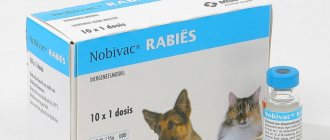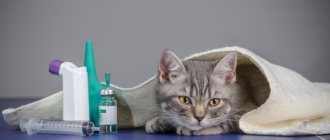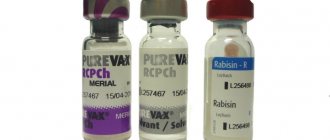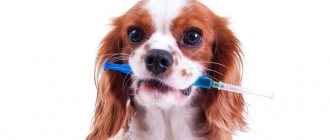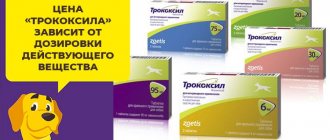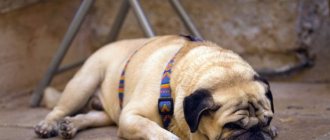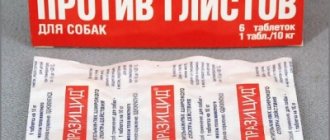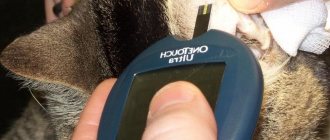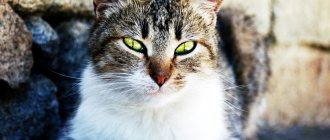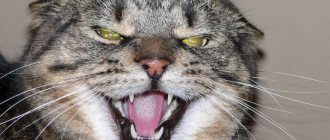4 / 5 ( 6 votes)
| Description of the drug | |
| Release form and storage conditions: | Vaccines in the form of a dry part (white or pinkish powder) and a liquid solvent (clear liquid), are packaged in glass ampoules; Shelf life of the powder is 24 months at a temperature of 2-8°C, shelf life of the solvent is 60 months at 2-25°C |
| Price: | 70-750 rubles per 1 dose (1 ml bottle) depending on the type of vaccine |
| Analogues: | Multikan, Geksakanivac, Dipentovak |
What is Nobivak used for?
Vaccination of animals against various diseases is the most reliable prevention. It helps to develop lasting immunity to those viruses, the consequences of infection of which can be fatal. The body is not able to overcome the infection of canine distemper or rabies on its own.
In some cases, dogs become dangerous to humans. Therefore, there are a number of vaccinations required for all pets. It is legally established that the owner takes responsibility not only for the health of the pet, but also for possible infected others.
The two main vaccines required to transport dogs across the border are:
- Vaccination against plague, parainfluenza, hepatitis, parvovirus enteritis;
- Rabies vaccination.
It is these injections that are given to the puppy and repeated annually. There are many vaccine strains in the Nobivak series of drugs; DHPPI (distemper, parainfluenza, hepatitis, enteritis) and Rabies (rabies) are intended for regular vaccination.
The following types are also distinguished:
- Lepto (leptospirosis, considered an add-on to DHPPI, mixed with the main vaccine);
- RL (rabies and leptospirosis, intended for revaccination);
- L4 (extended leptospirosis vaccine);
- PuppyDP (parvovirus enteritis and distemper);
- DHP (distemper, parvovirus enteritis, hepatitis);
- KC (parainfluenza and bordetellosis).
The drugs were developed in one Norwegian company - Intervet International B.V., which was founded in 1969. There is a branch of the Intervet organization in Russia; the Nobivak product was registered in 2014.
NOBIVAC® RL
For veterinary use only or under the supervision of persons registered or authorized under the Veterinary Medicine Act. Nobivac® RL is an inactivated vaccine for the active immunization of healthy dogs against rabies and leptospirosis in dogs caused by Leptospira interrogans serogroups Canicola and Icterohaemorrhagiae.
Each 1 ml dose of Nobivac RL contains at least 3 IU, as measured in mouse potency.
test of the rabies virus strain Pasteur RIV, grown in cell culture and inactivated with BPL, as well as BPL-inactivated Leptospira interrogans serogroup Canicola, strain Ca-12-000 ≥ 40 hamster PD80 and Icterohaemorrhagiae, strain 820K ≥ 40 hamster PD80 with aluminum. phosphate as an adjuvant and thiomersal as a preservative.
Nobivac DHPPI
This is a complex vaccine intended for vaccination and revaccination of dogs . It reliably protects your pet and contains inactive strains of canine distemper, infectious hepatitis, parainfluenza and parvovirus enteritis. Presented in the form of two ampoules: one of them contains a white or pinkish powder, and the second contains diluent (solvent).
The drug is used only for healthy animals and is safe for pregnant and postpartum females. The first vaccination is given at 8-9 weeks (from birth). Revaccination is carried out after 14 days . Subsequent repetitions depend on the breed and size of the pet. It is considered correct to vaccinate again at 6 and 12 months , and then annually . The average cost for one dose is 150 rubles ; together with the services of a veterinary clinic, vaccination will cost 400-500 rubles .
In order not to traumatize the pet’s psyche several times, Lepto against leptospirosis is administered along with this vaccine.
Instructions
All types of vaccines have approximately the same instructions. According to veterinary rules, dogs are vaccinated at one and a half to two months. At this age, the immunity acquired from the mother begins to decrease in puppies, and a replacement needs to be created. The polyvalent Nobivac vaccine for dogs DHPP and nobivac dhppi is considered safe. They combine 5 strains of inactivated viruses. One injection can protect a dog from five diseases. Nobivak polyvalent complex vaccines are recognized as completely safe, but it is not recommended to arbitrarily mix vials for one injection.
If veterinary advice is not possible, a vaccination schedule should be established. To protect your pet, Nobivac Rabies (or RL) and Nobivac Lepto (or L4) are required. After the first injection, the second can be done two weeks later. One-time Nobivac KC promotes the development of immunity against bordetellosis and parainfluenza. Dogs are vaccinated from 2 weeks of age, 0.4 ml intranasally (regardless of the size of the puppy). Revaccination is done every year.
Vaccination scheme
Your dog should be vaccinated according to schedule. It is necessary to maintain an interval between injections. The first subcutaneous vaccination is given at 1.5-2 months. Puppy DP is used from 4 weeks. The basic scheme for vaccinating dogs with Nobivak is as follows:
- 2 months (8 weeks): second vaccination (DHP + L).
- 3 months (12 weeks): third vaccination (DHPPi + LR).
A two-week quarantine is recommended after the third vaccination. The following scheme works:
- One year later: fourth vaccination (DHPPi + LR).
- Annually (DHPPi + LR).
- Humidifier for children: which one to choose
- What can be made from rubber bands, except for a bracelet, photo. Weaving from rubber bands, video
- Dorado in the oven - recipes with photos. How to deliciously cook dorado fish baked in the oven in foil
Nobivac Rabies
A vaccine designed to protect a pet from rabies . It contains killed viruses grown in an artificial environment. It looks like a ready-made suspension of yellowish color. The solution is administered at 3-12 months for the first time and repeated every three years. Moreover, the effect begins after 3 weeks , and the drug works for up to 36 months . In particularly dangerous conditions (with a high incidence of disease in the region), annual vaccination is permitted.
The average cost is 180 rubles . The total price of a specialist’s work is 350-500 rubles .
Instructions for use
Puppies begin to be vaccinated at the age of 6-8 weeks , when they stop receiving maternal immunity through milk. During this period, the pet is prohibited from communicating with other animals and going outside. 2 weeks before vaccination, the pet (of any age) is dewormed (cleansed of internal parasites).
It is recommended to consult with the breeder and veterinarian to select the ideal vaccine and draw up a vaccination plan. Often, puppies are purchased already vaccinated, but the further vaccination schedule rests on the shoulders of the owner.
For the first time, you should go to the clinic, where the vaccination procedure will be carried out by experienced specialists who will monitor the animal’s reaction to the drug. 2 weeks after the first vaccination, the injection is repeated. The further plan is developed individually for each dog. It is important to observe quarantine after each procedure ( 14-22 days ) and revaccinate dogs annually.
Vaccination schedule with Nobivak
A specific regimen can be prescribed individually depending on the breed and size of the dog. The ideal option would be to vaccinate with several types of Nobivak vaccine as the puppy grows older. For the first year, a similar plan would be suitable:
- Puppy DP vaccination at 1.5-2 months (subcutaneous);
- Inoculate DHP and L4 together at 8 weeks (subcutaneous);
- At 3-6 months you need to repeat the vaccination and add a strain of rabies, Nobivak DHPPI and RL are suitable;
- The last vaccination is repeated annually; in favorable conditions, revaccination is allowed once every 2 years.
This scheme is an example of a grafting option. You can choose other Nobivak vaccines or products from another company; it is important that the puppy receives protection from all dangerous diseases.
Composition and pharmacological properties
Depending on the type of drug, the content of vaccine strains will be different. For the most part, the solutions are similar, but have detailed properties. Nobivak DHPPI is considered the most complex; using its example, you can consider the common components of all mixtures:
- Plague strain (4.0 LH);
- Adenovirus strain (4.0 LH);
- Parvovirus strain (7.0 LH);
- Parainfluenza strain (5.5 LH).
The solvent contains water for injection, phosphate buffer solution.
Similar inactive strains contain other vaccines, to which a strain of rabies and leptospirosis can be added.
Effect of the drug
Like all vaccines, Nobivak drugs are based on the work of inactive strains (samples of viral bodies), which are introduced into the animal’s body, but do not have sufficient strength to attack it. At this time, the dog's immune system studies microorganisms and “learns” to resist them. Thus, after infection with a live virus, antibodies will be able to protect the dog’s organ systems.
Depending on the type of vaccination, the duration of protection is 12-36 months. The drug begins to work within 12-15 days, this time is called quarantine.
Indications for use
Indications for the use of specific types of vaccines depend on their functional effects. The full range of vaccinations is carried out for preventive purposes, and not after infection. The manufacturer assures that its products will reliably protect pets from dangerous viral diseases.
- Rabies is the most dangerous and intractable disease that destroys the dog’s central nervous system. It is also dangerous for humans. An animal can become infected from wild animals after a bite or through close contact with other domestic animals. The route of transmission is from saliva to blood. Characteristic symptoms are photophobia, convulsions, and severe drooling.
- Parvovirus enteritis is a viral disease that destroys the intestines and, in some cases, the heart of an animal. Transmitted through the feces of infected animals. Causes severe acute poisoning, diarrhea, vomiting, and a cadaverous odor. If the cells of the cardiovascular system are destroyed, the pet breathes heavily.
- Infectious hepatitis or adenoviral enteritis affects the liver, intestines, lungs, stomach, and nervous system. Caused by a blood-borne virus. Vivid signs are anemia, yellowing of the whites of the eyes and mucous membranes, fever, convulsions.
- Carnivore distemper is not dangerous to humans, but is fatal to pets in the absence of high-quality, quick treatment. Symptoms directly depend on the affected area. An obvious virus is keratinization of the skin and scabs on the surface of the epidermis.
- Parainfluenza is an insidious disease; the virus targets the lungs, then the gastrointestinal system and blood vessels. Manifests itself in the form of severe nasal discharge, coughing, sneezing, shortness of breath, anemia, and thirst.
- Leptospirosis is a bacterial disease that affects the kidneys, liver and circulatory system. In severe cases, it kills the internal microflora of the stomach, gastrointestinal tract, and nervous system.
Contraindications and side effects
For this vaccine, the list of contraindications is standard. Puppies under 2 weeks of age , sick and weakened pets, and dogs sensitive to the components of the drug are not allowed to be vaccinated. Nobivak is allowed even for pregnant and lactating females, but only after consultation with a veterinarian.
The vaccine is considered safe, but short-acting side effects may occur:
- Apathy, lack of appetite;
- Nausea;
- Shiver;
- A small bump at the injection site.
During the first few hours, you need to carefully monitor your pet. If you experience convulsions, severe fever, diarrhea, vomiting, or irritation at the puncture site, you should contact the clinic. Otherwise, deadly symptoms may occur: hives in the nose, swelling of the muzzle, sneezing and breathing problems, increased salivation, and tearing.
What is Nobivak for dogs
The Nobivak vaccine for dogs helps create protection against diseases in the animal’s body. The drug contains inactivated viruses that stimulate the immune system, allowing the immune system to study pathogens, find ways to counteract them and prepare for their possible invasion. If a dog does become infected with the virus, everything in its body will be ready to produce antibodies.
Vaccinations are given according to the plan developed by the veterinarian. If you intend to install them yourself, you need to follow the sequence. First, mandatory vaccinations against hepatitis, distemper and rabies are given. Other vaccines are recommended based on the epidemiological situation in the area where the animal lives. Then you can additionally get vaccinated against influenza, respiratory viruses and bordetellosis.
How to vaccinate a dog with Nobivac
You can vaccinate your pet yourself, provided you are fully aware of the rules of vaccination techniques. It is better to carry out the first procedure at a veterinary clinic to avoid problems with the acceptance of the vaccine. Two weeks before the injection, the pet is cleared of helminths. On the day of vaccination, you need to make sure that the dog is completely healthy. To do this, just measure the temperature.
Algorithm of actions for self-vaccination:
- The bottle with liquid content is heated in the hands and shaken; if you need to mix 2 components, then you need to sprinkle this amount of powder onto the solvent in accordance with the instructions;
- The resulting solution is drawn into a disposable thin syringe;
- Small pets are placed on a table or couch, held by the body or muzzle, large animals are seated between the legs and pinched with the knees;
- The desired area is NOT treated with alcohol or other antiseptics, because... disinfectants can inactivate the vaccine, rendering all actions useless;
- The drug is quickly injected with one click subcutaneously (to do this, the skin in the withers area is slightly pulled back) or into the thigh (only for Nobivak Rabies);
- Stickers from the bottles are placed in the veterinary passport, the bottles are boiled for several minutes, and then disposed of.
special instructions
The most important thing when vaccinating an animal is compliance with safety precautions and sterility of equipment (use of disposable syringes, needles). It is important that everyone in the room washes their hands and puts on special clothing . The surface on which the procedure is performed must be clean, disinfected with an alcohol solution or covered with a disposable diaper.
The use of the vaccine on people is prohibited . If the drug gets into the blood, you need to urgently go to the clinic. If liquid is spilled on the skin or mucous membranes (of both humans and animals), it is important to rinse the affected area with running water and monitor for a possible reaction.
It is necessary to have a first aid kit and first aid supplies so that it is possible to save the animal if allergic symptoms of not taking the drug appear.
Nobivac RL 1 dose
Instructions for the use of the Nobivak RL vaccine against rabies and leptospirosis in dogs, inactivated (Development organization: / Intervet International B.V., the Netherlands) Approved by Rosselkhoznadzor on February 12, 2014.
I. General information Trade name: Nobivac RL (Nobivac RL). International nonproprietary name: vaccine against rabies and canine leptospirosis, inactivated.
Dosage form: suspension for injection.
The vaccine is made from the cultural fluid of a continuous cell line BHK-21 clone CT infected with the rabies virus (strain Pasteur RJV), from cultures of leptospira serogroups Canicola (strain Ca-12-000) and Icterohaemorrhagiae (strain 820K), inactivated by 13-propiolactone, with the addition adjuvant - 2% solution of aluminum phosphate (146 mg), preservative - thiomersal (0.1 mg), and auxiliary components: sodium hydrogen phosphate dihydrate (5.2 mg), sodium dihydrogen phosphate dihydrate (0.9 mg), water for injection ( up to 1 ml).
In appearance, the vaccine is a suspension from yellow-brown to crimson color. A slight sediment may form, which easily breaks up when shaken.
The vaccine is packaged in 1 ml (1 dose) in glass vials of appropriate capacity, hermetically sealed with rubber stoppers reinforced with aluminum caps.
Vials of the vaccine are packed in 10 pieces in cardboard or plastic boxes. Each box contains instructions for using the vaccine in Russian. Boxes with the vaccine are placed in cardboard boxes.
The shelf life of the vaccine is 36 months from the date of release, subject to storage and transportation conditions. After the expiration date, the vaccine is not suitable for use.
The vaccine is stored and transported in a dry, dark place at a temperature of 2 °C to 8 °C.
The vaccine should be stored out of the reach of children.
Vaccine in vials without markings, with the integrity and/or tightness of the closure broken, with a changed appearance, with an expired expiration date, not used within 24 hours after opening the vials, is rejected, disinfected by boiling for 30 minutes and disposed of. Disposal of decontaminated vaccine does not require special precautions.
II. Biological properties The vaccine causes the formation of an immune response in dogs to the rabies pathogen 21 days after a single use for up to 3 years; to pathogens of leptospirosis - 21 days after repeated use, for up to 12 months. The vaccine is harmless and has no medicinal properties.
III. Directions for use The vaccine is intended for the prevention of rabies, leptospirosis and leptospirosis in dogs.
It is prohibited to vaccinate clinically sick and/or weakened animals. Dogs are not subject to vaccination two weeks before and three weeks after whelping.
Dogs are subject to vaccination starting from 8-9 weeks of age. The vaccine is administered subcutaneously once in a volume of 1 ml.
The Nobivak RL vaccine is part of a comprehensive immunization program with Nobivak vaccines and is recommended for use in combination with the Nobivak Lepto vaccine according to the following regimens:
- Nobivak4 Lepto vaccine at 8-9 weeks of age, followed by immunization with Nobivak RL vaccine at 12 weeks;
- Nobivak RL vaccine at 12 weeks of age followed by immunization with Nobivak® Lepto vaccine at 14 weeks;
- in case of threat of infection with the rabies virus, to ensure early protection, dogs are vaccinated twice at 8 and 12 weeks of age with the Nobivak RL vaccine
Adult, previously unvaccinated dogs are immunized with the Nobivak RL vaccine once, with repeated vaccination with Nobivak Lepto after 2-3 weeks.
Revaccination of animals with the Nobivak RL vaccine is carried out once a year.
Shake the vaccine vials before use. When carrying out vaccination, the rules of asepsis and antiseptics are observed. The vaccine injection site is treated with 70% alcohol.
Symptoms of rabies and leptospirosis, or other pathological signs of an overdose of the vaccine have not been established.
The characteristics of post-vaccination reactions during the first and subsequent administrations of the vaccine have not been established.
Violations of the vaccination schedule should be avoided, as this may lead to a decrease in the effectiveness of immunoprophylaxis for rabies and leptospirosis.
As a rule, there are no side effects or complications when using the vaccine in accordance with these instructions. A slight swelling may form at the injection site, spontaneously disappearing within one to two weeks. In case of allergic reactions to the vaccine in some animals, symptomatic treatment must be carried out.
The Nobivak RL vaccine can be used as a diluent for the Nobivak DHPPi and Nobivak DHP vaccines.
It is not recommended to vaccinate animals within 7 days after deworming.
The timing of possible use of animal products after the introduction of the Nobivak RL vaccine has not been established.
IV. Personal preventive measures When working with the vaccine, you should follow the general rules of personal hygiene and safety precautions provided for when working with veterinary medicinal products.
All persons participating in vaccination must wear special clothing and be provided with personal protective equipment. Places of work must have a first aid kit.
If the vaccine gets on the skin and/or mucous membranes, wash them with clean water. If the vaccine is accidentally administered to a person, the injection site must be treated with an antiseptic (5% iodine solution or 70% ethyl alcohol solution) and contact a medical facility.
Reviews about the drug from dog owners and veterinarians
The drug is considered affordable and widespread . It is used both in nurseries and veterinary clinics. Dog breeders and experts consider Nobivak a high-quality vaccine, but some users are unhappy with side effects and low effectiveness. Although the second parameter is not supported by evidence, because in order for the drug to work, you must follow all the rules of vaccination. Vaccination is carried out both in a clinic and in person, which once again confirms the availability of the medicine on the Russian market.
- Elena, dog breeder:
“We have been vaccinating with Nobivak for a long time, we trust vaccines, but the last vaccination did not work for my Briard. The dog was weak, refused to eat, and the lump took a very long time to dissolve. It was lucky that the dog was already an adult and returned to normal condition within a week. I don’t know what would have happened to the puppy. We are still afraid to use another vaccine.”
- Elena, Spitz owner:
“I bought a puppy with all its vaccinations, but it still needs to be revaccinated annually. There are no professional veterinary clinics in the city. I had to inject the baby myself. A very simple procedure, I ordered the Nobivak vaccine on the company website. The parcel arrived quickly. There are no side effects.”
- Ilona, veterinarian, dachshund owner:
“The vaccine has been used in our clinic for a long time, and clients do not complain, and it is convenient for us to work. The drug is not expensive, high quality, accessible. We order directly. The most important thing is to correctly determine the type of vaccine, because each disease requires its own strain. In some cases, side effects do occur, but they go away quickly and therefore do not pose a danger to animals.”
Reviews from the Internet:
Any veterinarian and even an amateur dog breeder will tell you about the importance of vaccinating dogs, even those who do not go outside. Vaccinations will not harm the animal if they are carried out in accordance with the rules of hygiene and general vaccination. Without protection, a pet is guaranteed to be at risk. But curing a disease is always more difficult than preventing its occurrence.
Learn about essential drugs in animals
- Vaccination of puppies
- Vaccination of domestic cats against rabies, panleukopenia, calicivirus, heprevirus infection, leukemia, chlamydia, bordetellosis
- Vaccination of small pets
- Vaccination of kittens. Why vaccinate kittens?
- Vaccination of dogs against rabies, canine distemper, parvovirus enteritis, leptospirosis, viral hepatitis and parainfluenza. Why give vaccines to dogs?
- Why do kittens need to be vaccinated? Which drugs are better? How will he feel after the injection?
- Nobivak Triket Trio: Instructions for use for cats. Why do cats need Nobivak Triket?
- Nobivac DHPPi for dogs
- Puppy's first vaccination and revaccination
- Complex vaccinations for cats (against several infections at once, for example, rabies, rhinotracheitis, panleukopenia and calicivirus)
- Tick vaccination for dogs. Myths and reality
- What vaccinations are given to dogs and why? How many drugs should be administered? How to prepare a dog for a course of comprehensive vaccinations?
- Why is Ursofalk prescribed to cats?
- Instructions for the use of serenia in animals
- Ursofalk in dogs. Why is Ursofalk prescribed to a dog?
- Marfloxin for veterinary medicine
- Instructions for the use of serenia in dogs
- Instructions for using serenia in cats
- Why is Heptor prescribed to a dog?
- Instructions for the use of lidocaine in dogs
- Heptor in cats
- Lidocaine for cats. Can cats use lidocaine?
- Heptral in dogs (instructions for use, pharmacology, use in veterinary clinics, dosage, indications and contraindications)
- Can cats use marfloxin?
- Marfloxin for dogs (instructions for use). Can dogs use marfloxin?
- Heptral in cats (instructions for use, pharmacology, use in clinics, dosage, indications and contraindications)
- Instructions for use of Dirofen in cats
- Instructions for using Vetom in cats
- Instructions for using multifel in cats
- Instructions for use of fosprenil in cats
^Top
